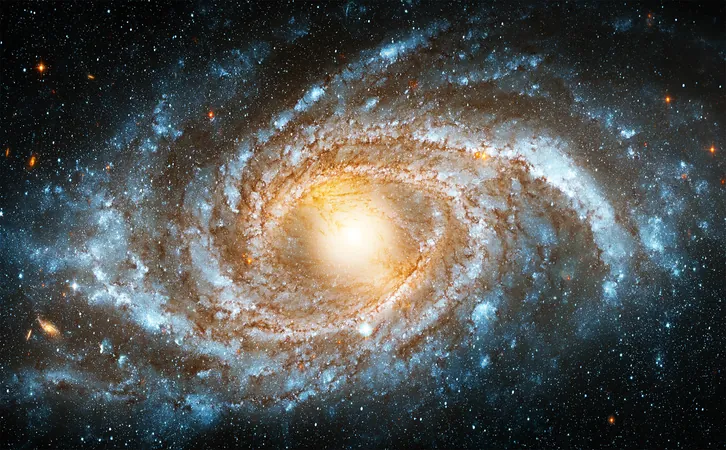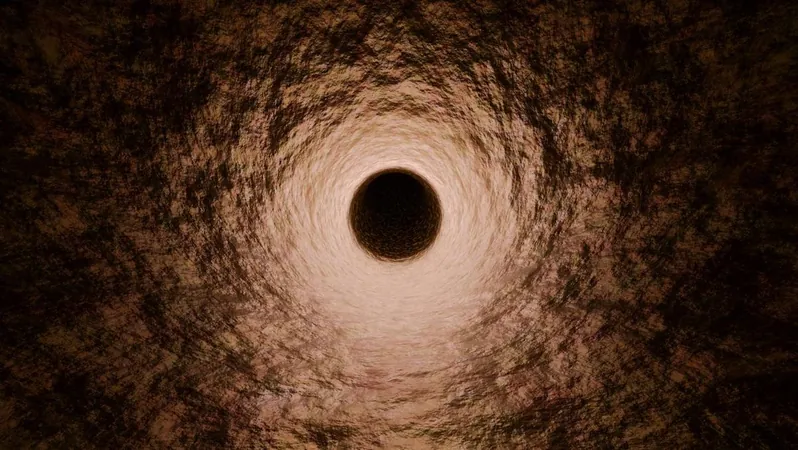
Astounding Discovery: Spiral Galaxy Challenges Our Understanding of Galactic Formation
2025-03-24
Author: Ying
In an unprecedented revelation, astronomers from Christ University in Bangalore, alongside an international collaborative team, have unveiled a colossal spiral galaxy that defies our conventional understanding of galactic behavior. The galaxy, named 2MASX J23453268−0449256, is situated nearly a billion light-years away and exhibits characteristics that challenge long-held theories about how galaxies evolve and interact with their supermassive black holes.
A Cosmic Enigma
What sets this galaxy apart is its remarkable stability despite displaying extreme cosmic phenomena. At its center, a supermassive black hole, billions of times heavier than our Sun, ejects colossal jets of energy that stretch an astonishing six million light-years into space—approximately sixty times the diameter of the Milky Way. Typically, such potent jets are characteristics of elliptical galaxies, making the peaceful presence of this spiral galaxy even more perplexing.
Professor Joydeep Bagchi, the lead author of the study, stated, “This discovery is a groundbreaking anomaly that forces us to rethink the entire framework of galactic evolution. If a spiral galaxy can not only survive but thrive under such harsh conditions, we must consider the implications for the future of galaxies like our own Milky Way.”
A Look at Internal Dynamics
The research team employed an array of sophisticated instruments, including the Hubble Space Telescope, the Giant Metrewave Radio Telescope, and the Atacama Large Millimeter/submillimeter Array (ALMA), to probe this enigmatic galaxy. Their analysis revealed a magnificently intact structure, characterized by elegantly spiraling arms, a bright central bar, and a serene ring of stars enveloping its core. This tranquil appearance masks the intense energy and chaos emanating from within.
Surrounding the galaxy is an immense halo of hot gas that emits X-ray light, indicating exceptionally high temperatures. Surprisingly, this hot gas should typically cool over time, fostering new star formation. However, the ongoing jets from the black hole exacerbate these temperatures, maintaining a dynamic environment that halts the birth of new stars.
What If Our Galaxy Faces a Similar Fate?
Given the findings regarding 2MASX J23453268−0449256, questions arise about the future of our own Milky Way. Currently, our central black hole, Sagittarius A*, remains dormant and quiet. However, should a nearby gas cloud, star, or smaller galaxy disturb it, a tidal disruption event (TDE) could ignite Sagittarius A* into a frenzy, potentially emitting powerful jets akin to those observed in this newly discovered galaxy.
If such an event were to target Earth, it could pose significant threats, from damaging our atmosphere to increasing mutation rates, with grave long-term consequences for life on our planet. Even without extinction events, the jets may alter interstellar mediums, stopping star formation or reshaping our galaxy's dynamics.
The Role of Dark Matter in Stability
An essential aspect of the Galaxy's stability appears to be linked to dark matter. The research team surmised that 2MASX J23453268−0449256 likely contains ten times more dark matter than the Milky Way, providing the necessary gravitational force to stabilize the galactic structure amidst violent internal activity. By investigating the interplay between dark matter, the supermassive black hole, and the overall framework of the galaxy, researchers are gaining insights into the workings of galaxies under extreme conditions.
Co-author Shankar Ray emphasized, “Studying such unusual galaxies gives us critical insights into the unseen forces shaping our universe. It opens up discussions about dark matter, the ultimate fate of galaxies, and even the origins of life.”
The Unresolved Questions Ahead
Despite these revelations, many mysteries remain. Scientists are still trying to determine the frequency of such spiral galaxy formations and what activates supermassive black holes to produce immense jets. As each discovery leads to further inquiries, the question looms large: Is the Milky Way bracing itself for a dramatic transformation?
For now, the Milky Way continues in its peaceful state, as life on Earth persists. Yet the ever-evolving universe reminds us of the delicate balance that exists. Somewhere, a billion light-years away, an extraordinary spiral galaxy continues to defy expectations, adding to the enigmatic nature of our cosmos.
This groundbreaking study has been featured in the Monthly Notices of the Royal Astronomical Society, opening a pathway to new understandings of galactic behavior and the forces that govern them.



 Brasil (PT)
Brasil (PT)
 Canada (EN)
Canada (EN)
 Chile (ES)
Chile (ES)
 Česko (CS)
Česko (CS)
 대한민국 (KO)
대한민국 (KO)
 España (ES)
España (ES)
 France (FR)
France (FR)
 Hong Kong (EN)
Hong Kong (EN)
 Italia (IT)
Italia (IT)
 日本 (JA)
日本 (JA)
 Magyarország (HU)
Magyarország (HU)
 Norge (NO)
Norge (NO)
 Polska (PL)
Polska (PL)
 Schweiz (DE)
Schweiz (DE)
 Singapore (EN)
Singapore (EN)
 Sverige (SV)
Sverige (SV)
 Suomi (FI)
Suomi (FI)
 Türkiye (TR)
Türkiye (TR)
 الإمارات العربية المتحدة (AR)
الإمارات العربية المتحدة (AR)